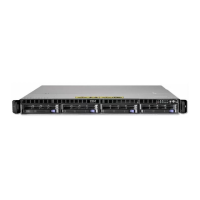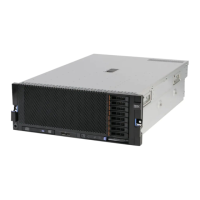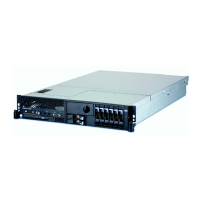9112 Model 265
The Model 265 is either a 1–way or 2–way system. The system can accommodate two processor cards,
one memory card with 16 DIMMs, and 5 PCI adapters. It supports six hot-swap DASD bays and one
floppy drive.
Dimensions
Height 426 mm (16.8 in.)
Width 215 mm (8.5 in.)
Depth 617 mm (24 in.)
Weight
Minimum configuration 35.5 kg 78 lbs.
Maximum configuration 43.1 kg 94.8 lbs.
Electrical
Power source loading (maximum in
kVA)
0.40
Power source loading (typical in
kVA)
0.30
Voltage range (V ac) 100 to 127 or 200 to 240 (autoranging)
Frequency (hertz) 50 or 60
Thermal output (maximum) 1306 Btu/hr
Thermal output (typical) 979 Btu/hr
Power requirements (maximum) 384 watts
Power requirements (typical) 288 watts
Power factor - US, World Trade,
Japan
0.96
Inrush current² 70 amps
Maximum altitude 2135 m (7000 ft.)
Temperature Requirements³ Operating
16 to 32°C
(61 to 90°F)
Non-Operating
10 to 43°C
(50 to 109°F)
Humidity Requirements⁴ Operating Non-Operating
(Noncondensing) 8 to 80% 8 to 80%
Wet Bulb 27°C (80°F) 27°C (80°F)
Noise Emissions¹ Operating Idle
L
WAd
6.1 bels 6.1 bels
L
pAm
42 dBA 41 dBA
Impulsive or prominent discrete
tones
No No
Install/Air Flow Maintenance of proper service clearance should allow proper air flow.
Service See service clearances for the 7014 T00 Rack
1. See “Noise Emission Notes” on page 336 for definitions of noise emissions positions. See noise emissions note
4.
2. Inrush currents occur only at initial application of power, no inrush occurs during normal power off-on cycle.
3. The upper limit of the dry bulb temperature must be derated 1 degree C per 137 m (450 ft.) above 915 m (3000
ft.).
4. The upper limit of the wet bulb temperature must be derated 1 degree C per 274 m (900 ft. ) above 305 m (1000
ft.).
5. Levels are for a single system installed in a T00 32 EIA rack with the center of the unit approximately 1500 mm
(59 in.) off the floor.
Chapter 2. Physical Characteristics of Systems 213

